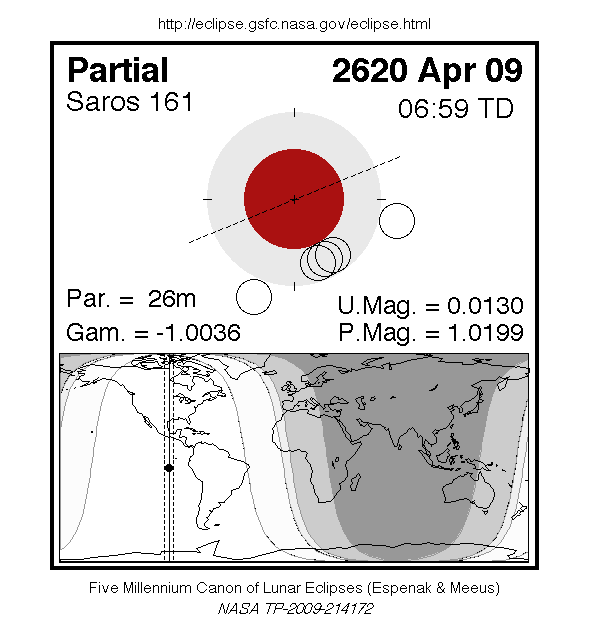A partial eclipse of the Moon occurs on Sunday 9 April, 2620 UT, with maximum eclipse at 06:25 UT. A tiny bite out of the Moon may be visible at maximum, though just 1% of the Moon will be shadowed in a partial eclipse lasting for 26 minutes exactly. A shading across the moon from the Earth's penumbral shadow should be visible at maximum eclipse.
The penumbral eclipse lasts for 4 hours and 20 minutes.
The partial eclipse lasts for 26 minutes exactly.
Maximum eclipse is at 06:25:03 UT.
Interactive Map
This map shows the visibility of the eclipse at maximum eclipse,
when it will be visible within the bright area on the map. Note that
the map is approximate, and if you
are near the edge of the area of visibility, the moon will be very close
to the horizon and may not be practically visible.
You can use the zoom controls to zoom in and out, and pan to
see areas of interest. The green marker in the centre shows where
the Moon will be directly overhead at maximum eclipse.
The interactive map is currently not available.
Overview Map
This map sourced from NASA Goddard Space flight Center: GSFC Eclipse Web SiteGSFC Eclipse Web Site
The primary source of all the information on eclipses presented here at Hermit Eclipse. (NASA Goddard Space flight Center)
shows the visibility of the eclipse. (Click on it for the
full-sized version.)
Eclipse Season and Saros Series
This eclipse season contains 2 eclipses:
This is the 21st eclipse in lunar Saros series 161.The surrounding eclipses in this Saros series are:
This Saros series, lunar Saros series 161,
is linked to solar Saros series 168. The
nearest partner eclipses in that series are:
Eclipse Parameters
| UT Date/time (max) | 06:25:03 on 9 Apr UT |
TDT Date/time (max) | 06:58:47 on 9 Apr TDT |
| Saros Series | 161 |
Number in Series | 21 |
| Penumbral Magnitiude | 1.0199 |
Central Magnitiude | 0.013 |
| Gamma | -1.0036 |
Path Width (km) | |
| Delta T | 33m44s |
Error | ± 28m14s (95%) |
| Penumbral Duration | 4h20m |
Partial Duration | 26m00s |
| Total Duration | |
| |
| Partial Rating | |
Total Rating | |
Note that while all dates and times on this site (except
where noted) are in UT, which is within a second of civil time,
the dates and times shown in NASA's eclipse listingsGSFC Eclipse Web Site
The primary source of all the information on eclipses presented here at Hermit Eclipse. (NASA Goddard Space flight Center)
are in the TDT timescale.
Data last updated: 2015-06-21 22:11:48 UTC.

